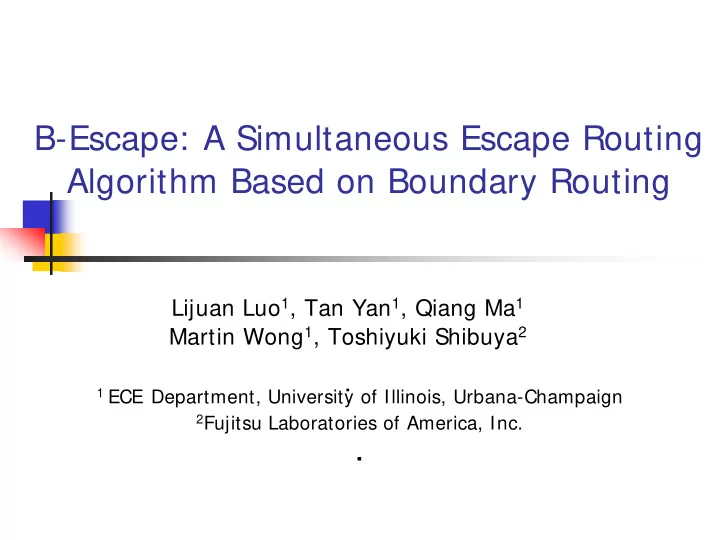

B-Escape: A Simultaneous Escape Routing Algorithm Based on Boundary Routing Lijuan Luo 1 , Tan Yan 1 , Qiang Ma 1 Martin Wong 1 , Toshiyuki Shibuya 2 1 ECE Department, University of Illinois, Urbana-Champaign . 2 Fujitsu Laboratories of America, Inc. .
Outline Introduction Our Algorithm (B-Escape) Boundary Routing Dynamic Net Ordering Implementation Details Experimental Results Conclusion
PCB Routing Escape routing
Escape Routing Problems 1 2 3 1 5 4 1 1 2 3 3 4 4 4 3 2 2 5 5 5 (a) Unordered Escape (b) Ordered Escape 1 5 1 3 3 2 2 4 4 5 (c) Simultaneous Escape
Previous Approaches Manual routing Time Consuming Pattern Routing Limited ability to do complex escapes Negotiated Congestion Routing Difficult to resolve crossings
Our Contributions Introduce a boundary routing approach Capable of handling complicated problems in very short time Solved 14 industrial benchmarks while Cadence Allegro only solved 7.
Focus on 1-side Escape Without loss of generality, we only consider 1-side Escape.
Ordered Escape Use ordered escape to present our boundary routing approach Foundation of our simultaneous escape
Routing Boundary The boundary of the maximum routable region for the unrouted pins Shrinks as we route more pins
Boundary Routing Methodology 16 12 16 12 11 13 11 13 14 14 17 17 15 15 (a) Boundary routing (b) Routing based on shortest path Tend to leave more space for the unrouted pins
Routing Modes 1 6 2 7 3 5 4 8 10 9 12 16 11 13 14 17 15 Upward Mode Downward Mode
Example Upward Mode 3 2 1
Routing Modes Up-down Mode Alternate between the up and down modes Trapped
Routing Modes Detour Modes Go leftward to reach the boundary Detour upward Detour downward Detour up-down Blocked (b) Detour upward (a) Upward
Six Routing Modes
Optimality for Monotonic Routing Guarantee an escape solution for monotonically escapable problems Monotonic routing (a); Non-monotonic routing (b) (c)
Dynamic Net Ordering Huge routability differences caused by slightly different net orderings Difficult to decide the correct ordering beforehand.
Dynamic Net Ordering Tentatively route each remaining net (using boundary routing) Choose the “ best ” one as the next net
Cost Function Trap cost: # Pin unroutable Block Cost: # Pin blocked (still routable) The overall cost takes both components into account.
Reordering Sometimes pins may get trapped Backtrack and get a different ordering
Detailed Modeling of Routing Grid Need to capture diagonal routing
Detailed Modeling of Routing Grid Introduce “ Switch-box ” into the grid structure The switching condition: No crossing Satisfy capacity constraint Track
Routing Differential Pairs Pair constraint: If two nets belong to a differential pair, they are required to route together. Solution Order the paired nets successively. (avoid (b)) Define a new boundary for paired nets.
Routing Differential Pairs
Experimental Setup Implemented in C+ + Pentium 4 2.8 GHz system with 4GB memory Benchmarks: 14 Industrial benchmarks Manually solved by designers for 8 hours/benchmark # Net (18~ 64) Grid size (16 × 14 ~ 38 × 36)
Experimental Results Benchmark Allegro B-Escape Routability comparison Ex1 100% 100% with Cadence Allegro Ex2 100% 100% PCB Router: Ex3 100% 100% Ex4 95% 100% 14/14 v.s. 7/14 Ex5 80% 100% Run time: Ex6 100% 100% Ex7 90% 100% B-Escape: 0.2s~ 691.3s Ex8 100% 100% Negotiated Congestion Ex9 100% 100% Router: 55.8s~ 6189.0s Ex10 95% 100% Ex11 96% 100% Ex12 100% 100% Ex13 70% 100% Ex14 80% 100% # routed problem 7/14 14/14
Experimental Results
Conclusion Currently escape problems are mostly solved manually We have presented a boundary routing method to solve complicated escape problems B-Escape outperforms the commercial PCB router.
Recommend
More recommend